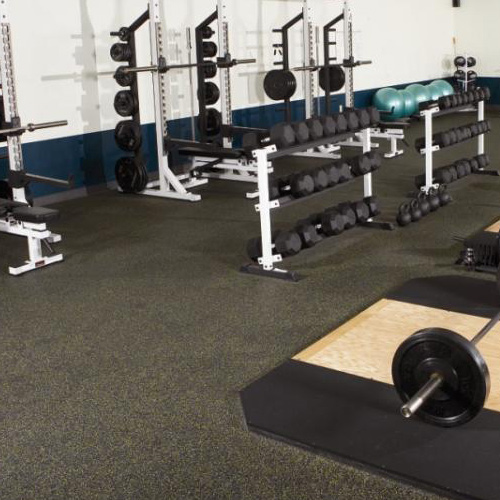What is the best flooring for a school weight room?
Related Product: Z Rubber Flooring Roll Geneva 3/8 Inch Regrind Per SF - Disc
Rubber is the most common weight room flooring. And when you consider the strengths of this material, it’s easy to understand why schools choose rubber flooring. Here are some of the reasons why rubber is the best flooring choice for a school weight room.
Multiple Use Cases
No matter what kind of weight training workouts will be performed, the appropriate thickness of rubber is able to handle it easily. Football players use a different workout regimen than basketball or volleyball players. Yet, all of these athletes will be using the weight room in the school at various times.You need weight room flooring that can support a multitude of different machines and weights to accommodate athletes from different teams. Rubber can support almost any amount of weight without indenting. And it will protect the subfloor from heavy weight training equipment.
No matter what level of athlete is using the space, rubber floors are a great choice for both safety and durability. Sports teams that use rubber flooring in a weight room include those in middle school, high school, college, and professional levels.
Great for Shared Spaces
Often times in a school, the weight room space will be used for a variety of purposes throughout the day.During the day, the school may choose to hold regular gym classes in the space. Before and after school, athletic teams may be using the space for sport specific workouts.
And in the evening or on the weekends, the school may open up the space to the public. At a university, students and faculty may be allowed to use the weight training space during hours when the athletic teams are not practicing.
Rubber is a safe weight room floor for people of varying ages. Because rubber is so easy to clean, the space can be used regularly, yet it can be sanitized quickly after one class to be ready for the next class.
Multiple Design Configurations

Another significant benefit of rubber is that it’s available in many different design choices and coverage sizes. Some designs are better suited for larger spaces than others.
- Roll. A roll of rubber gives schools the most value per square foot of coverage. It’s made to cover large spaces quickly. A roll of rubber weight room flooring is extremely heavy, so it helps to have multiple people available to move it into place.
- Mat. A rubber mat is made to cover small spaces in the weight room. Some schools will choose to use the mat underneath a piece of equipment, such as a treadmill or a weight machine - and most commonly under olympic lifting areas. Mats can be made extremely thick, so they’re also good for areas where heavy free weights will be dropped.
- Tile. Rubber tiles are made to cover any sized weight rooms - especially those that may be irregularly shaped. It consists of tiles of a manageable size, which simplifies installation and reduces waste when customization in necessary. And the tiles often have an interlocking edge, so they pop together securely and remain tightly connected, even when placed under stress. The also offer the greatest range of thicknesses.
Multiple Thickness Choices

The most common thickness options for rubber weight room floors are 1/4, 3/8, 1/2, 5/8, and 3/4 inches. You’ll also regularly find 8 mm and 10 mm thickness measurements. Specialty rubber tiles and mats may range from 1 to 2.75 inches in thickness.
Even though you can select thinner or thicker configurations, all types of rubber weight room flooring are extremely durable. Rubber used as flooring will have a warranty of between five and 15 years, which is perfect in a school, where products need to stand up to constant use. Be aware that the thicker the rubber the better protection the rubber will offer to your existing subfloor.
Shock Absorption and Noise Reduction Properties
Weight lifting often is a noisy type of exercise, as weights clang into each other or are dropped to the ground. Having rubber weight room flooring reduces the noise, as it absorbs impact when the weights hit the ground.Rubber isn’t a soft material, but it does have a little bit of give to it as people walk on it, which is helpful for the knee and ankle joints of the weightlifters. Rubber also gives the weightlifters a sure footing, so they don’t slip during a strenuous exercise.
Specially designed rubber tiles can even virtually eliminate the floor vibration caused by dropped weights.
Multiple Color Choices
Rubber flooring typically will be all black in color. Sometimes, though, it will have color flecks added to the black to create an interesting pattern in the floor. Occasionally, you’ll find a non-black full color option. Another nice looking option is a cork-rubber mixture.You can lay rubber over multiple types of subfloors. But in school weight rooms, you’ll often have a cement subfloor, which pairs nicely with a rubber flooring.
Ultimately, the ideas for using rubber weight room flooring are only limited by your imagination. Rubber floors are available at a variety of price points, meaning there are plenty of products available to fit into the budget of a school or athletic team.










